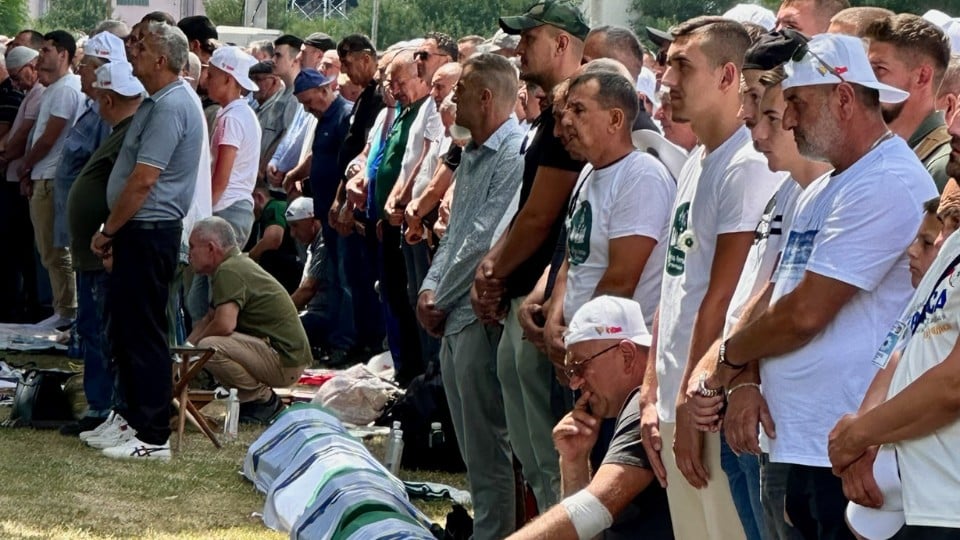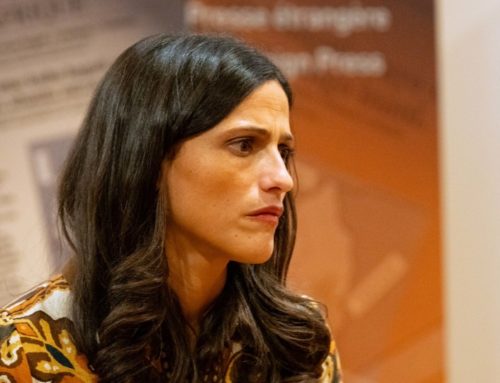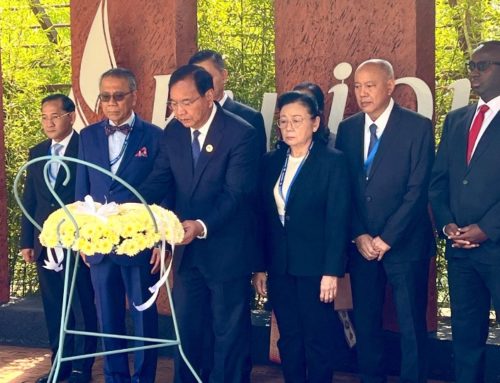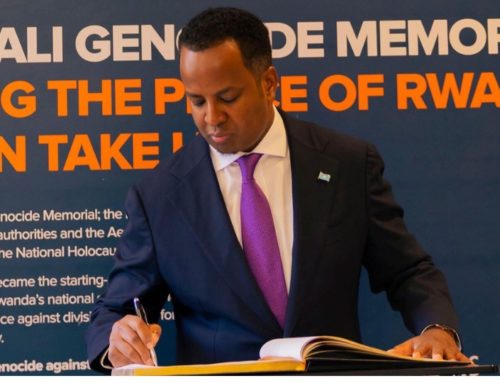Aegis Trust Founder Dr James Smith took part in a week of events in Bosnia this month to commemorate the 30th anniversary of the Srebrenica Genocide. Here, he reflects on those events and their significance for Bosnia and the international community today.
(12-minute read)
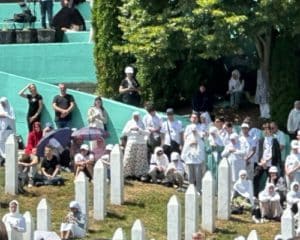 I was privileged to participate in the 30th commemoration of the Srebrenica genocide. Etched onto my memory are scenes from the Srebrenica Genocide Memorial’s cemetery on 11 July: Families still burying their dead thirty years later, kneeling by green cloth-covered caskets, waiting for hours in the baking sun for the religious ceremony to begin. Stretched out over the hillsides behind them, thousands huddle amidst seemingly-endless tall, thin white gravestones, each inscribed with the name of a father, brother, uncle or son. As the guests lined up to enter the already packed cemetery, the haunting lament “Srebrenica Inferno” rolled out over us. Then Muslim clerics recited prayers for the dead, while dignitaries queued to lay white lilies at a mini cenotaph.
I was privileged to participate in the 30th commemoration of the Srebrenica genocide. Etched onto my memory are scenes from the Srebrenica Genocide Memorial’s cemetery on 11 July: Families still burying their dead thirty years later, kneeling by green cloth-covered caskets, waiting for hours in the baking sun for the religious ceremony to begin. Stretched out over the hillsides behind them, thousands huddle amidst seemingly-endless tall, thin white gravestones, each inscribed with the name of a father, brother, uncle or son. As the guests lined up to enter the already packed cemetery, the haunting lament “Srebrenica Inferno” rolled out over us. Then Muslim clerics recited prayers for the dead, while dignitaries queued to lay white lilies at a mini cenotaph.
As the ceremony came to an end, the Republika Srpska police, who three decades earlier had been part of the genocide, now did their best to direct traffic jams that brought roads to a standstill, as foreigners and media rushed to get away. I felt a pang of regret that I too was part of the exodus, heading to a meeting in Sarajevo. Walking along the road, I passed row upon row of men still at prayer. Soon, many of them would also depart, leaving the survivors and memory workers in exhausted silence.
The religious service I was now leaving concluded a week of major events, all held around the anniversary.
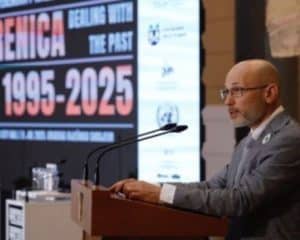 Arriving in Sarajevo a few days earlier, I’d had the honour of giving opening remarks at an international conference organised by Aegis Trust’s partners, the Sarajevo-based Post-Conflict Research Centre. Headed by Velma Šarić, the P-CRC are resolute peacebuilders and storytellers. Their conference was held in the splendid Sarajevo City Hall, destroyed during the siege by Bosnian Serbs. Now beautifully restored, it’s a symbol of rebuilding and recovery. On display was a powerful exhibition of survivor portraits. Hanging just above them were hundreds of coloured scarves, collected by Velma from women around the world, as an act of solidarity with the women of Srebrenica. The Duchess of Edinburgh, visiting on behalf of King Charles, donated a scarf.
Arriving in Sarajevo a few days earlier, I’d had the honour of giving opening remarks at an international conference organised by Aegis Trust’s partners, the Sarajevo-based Post-Conflict Research Centre. Headed by Velma Šarić, the P-CRC are resolute peacebuilders and storytellers. Their conference was held in the splendid Sarajevo City Hall, destroyed during the siege by Bosnian Serbs. Now beautifully restored, it’s a symbol of rebuilding and recovery. On display was a powerful exhibition of survivor portraits. Hanging just above them were hundreds of coloured scarves, collected by Velma from women around the world, as an act of solidarity with the women of Srebrenica. The Duchess of Edinburgh, visiting on behalf of King Charles, donated a scarf.
The warmth of the welcome in Sarajevo was humbling, given the international community’s catastrophic failure in Bosnia.
After calling in to the ‘Why Remember?’ conference to present about Aegis Trust’s peacebuilding work in Rwanda we headed out to Srebrenica, to join the commemorative programmes there.
Along the route were at least four new Orthodox Churches, often with small footprints yet prominent on the landscape.
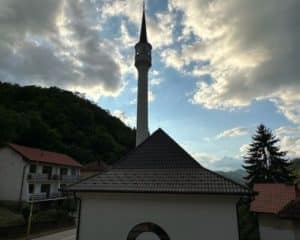 With barely any houses or people nearby it seems they are built more as a statement than as places of worship. Rumours are that the Serbian Orthodox church has received funding from Russia for some of the churches being built in this new wave of religious construction across Republika Srpska. Perhaps that is to counter funds from Turkey, Iran and Saudi Arabia, who have restored the Ottoman-era mosques destroyed by Serbs in the 1990s war. Since restoration is coming to an end, the same foreign funds are helping to build new mosques. One new church is on a hill a few minutes above the Memorial. In front of it is a covered area for benches and tables, with a fireplace at one end to make barbeques for social gatherings. The fireplace lies a few metres from a depression in the earth; the “Budak 2” secondary mass grave used by the Serbs to hide the remains of Muslims killed in 1995.
With barely any houses or people nearby it seems they are built more as a statement than as places of worship. Rumours are that the Serbian Orthodox church has received funding from Russia for some of the churches being built in this new wave of religious construction across Republika Srpska. Perhaps that is to counter funds from Turkey, Iran and Saudi Arabia, who have restored the Ottoman-era mosques destroyed by Serbs in the 1990s war. Since restoration is coming to an end, the same foreign funds are helping to build new mosques. One new church is on a hill a few minutes above the Memorial. In front of it is a covered area for benches and tables, with a fireplace at one end to make barbeques for social gatherings. The fireplace lies a few metres from a depression in the earth; the “Budak 2” secondary mass grave used by the Serbs to hide the remains of Muslims killed in 1995.
The following morning, I shared with students at P-CRC’s Srebrenica Summer School how Aegis used storytelling to shape narratives in post-genocide Rwanda with the aim of encouraging unity, empathy and reconciliation. I then headed to the Srebrenica Genocide Memorial for the last day of their pre-commemoration conference. Some of the memorial’s staff and survivors had flown overnight from an UNGA event in New York. With barely a few hours’ sleep they were back at work in front of a myriad cameras, sharing their stories and sorrow.
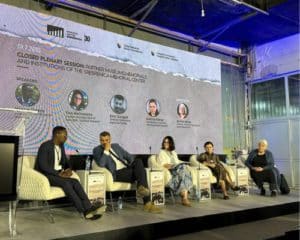 Conversing with leaders from Holocaust museums in Europe, my colleague from Kigali Genocide Memorial, Honore Gatera, noted how all of them face challenges of genocide denial and that there should be cooperation between memorials to address it.
Conversing with leaders from Holocaust museums in Europe, my colleague from Kigali Genocide Memorial, Honore Gatera, noted how all of them face challenges of genocide denial and that there should be cooperation between memorials to address it.
Asked what memorials are doing to prevent genocide, the Srebrenica Memorial director, Dr. Emir Suljagić, commented that genocide memorials don’t have the capacity to prevent genocide, as this is the realm of governments, however they can and should do much more to work together to combat factors that lead to atrocities – including hate and disinformation that are growing exponentially, especially online.
I met up with Hasan Hasanović, the Memorial’s oral history expert, who showed me around the new exhibition he had created. Hasan survived the ‘death march’ of men and boys who fled Srebrenica after it fell to the Bosnian Serbs. Tragically, his twin brother and father didn’t, murdered by the Bosnian Serbs in the surrounding hills. Now, Hasan curates a world class museum, filled with eyewitness testimony and personal artefacts of the victims, donated by families who survived them. They are displayed in the factory where Bosniak refugees had gathered in the belief the UN peacekeepers would protect them there. Another new exhibition was opened during the commemoration, built with millions of Euros donated by the Turkish government.
That night, I was hosted by a survivor, Berija, who still lives in Srebrenica. “Why should I leave the place I grew up? I stay here to honour my family and my husband.”
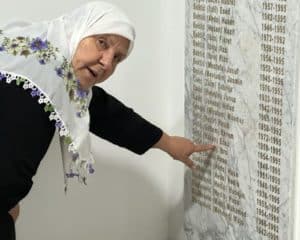 She lost him in the genocide. Taking me to the small mosque next to her house, Berija showed me the long list of names of the men and boys on her road who were murdered in Srebrenica three decades ago for having the wrong name; a Muslim name. She bent over to point out her father-in-law’s name, he had been the Imam of the mosque. Back in her home she provided us with delectable sweet cakes. Knowing I was British, she provided me with cup of tea. Even as a veteran of northern building sites, it was somewhat stronger than even I was accustomed to.
She lost him in the genocide. Taking me to the small mosque next to her house, Berija showed me the long list of names of the men and boys on her road who were murdered in Srebrenica three decades ago for having the wrong name; a Muslim name. She bent over to point out her father-in-law’s name, he had been the Imam of the mosque. Back in her home she provided us with delectable sweet cakes. Knowing I was British, she provided me with cup of tea. Even as a veteran of northern building sites, it was somewhat stronger than even I was accustomed to.
On the 11th of July, I was privileged to have a VIP pass to the commemoration, courtesy of P-CRC’s tireless young women. As they paused for a final cigarette before the ceremony, we watched limousines arrive one after another, stopping in front of the old factory that is now the Srebrenica memorial. Important people with bodyguards stepped out, shook hands with the chair of the memorial, and filed inside, whilst masses gathered on the roadside. Those waiting for their execution thirty years ago must have prayed and pleaded on this very soil for world leaders to fly in and rescue them, but the skies and roads remained empty. The dead, I thought, attract more attention than the living.
Speech after speech was delivered at the ceremony from high-level representatives from Europe, America, Turkey and international organisations, occasionally broken up by beautiful, mournful music.
Mid-way through, in the presence of dozens of foreign dignitaries, a formidable elderly woman in a head scarf took to the podium and berated us.
It wasn’t enough that we – the international community – were culpable for the murders of thousands, she scolded us, but “Europe continues to allow hate and lies” to intimidate survivors. We all stood –hundreds, maybe a thousand people – to give her an ovation. Everyone knew she was right. For three long decades, Munira Subašić, whose youngest son and husband were murdered (along with 22 family members) has tirelessly fought, along with other Mothers of Srebrenica, for justice. It was their determined campaign that drove the creation of the Memorial itself.
Hearing from Munira how much it meant to survivors, I felt proud that Aegis Trust had helped campaign for the UN Resolution for the establishment of the International Day of Reflection and Commemoration of the 1995 Genocide in Srebrenica. Rwanda and Germany co-sponsored the U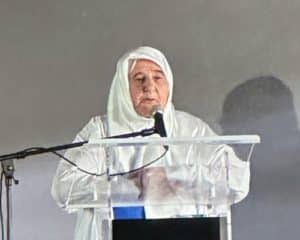 N resolution. Survivors of the 1994 Genocide against the Tutsi had sent messages of support from the Aegis-run Kigali Genocide Memorial. Alice Nderitu, the President of Aegis’ Isoko Centre for Humanity campaigned tirelessly when she was Under Secretary General responsible for genocide prevention, for the UN Resolution.
N resolution. Survivors of the 1994 Genocide against the Tutsi had sent messages of support from the Aegis-run Kigali Genocide Memorial. Alice Nderitu, the President of Aegis’ Isoko Centre for Humanity campaigned tirelessly when she was Under Secretary General responsible for genocide prevention, for the UN Resolution.
Following Munira, the Dutch Foreign Minister poetically acknowledged his government’s failure. He recalled how the detachment of Dutch UN Peacekeepers, based in the factory in which we now gathered, handed over Muslim men and boys under UN protection to the Bosnian Serbs nationalists, led by Ratko Mladic, who then murdered 8,372 of them. Women weren’t spared either. They were often raped; many were murdered.
Sophie, Duchess of Edinburgh, delivered a message from King Charles expressing his sorrow at the genocide and respect for the resilience of the survivors.
Her speech recognised the vital work of organisations like P-CRC in promoting tolerance and understanding across all faiths, nationalities and ethnicities.
Diplomats from the former Yugoslav states of Croatia, Montenegro and Slovenia were also present. For my local colleagues, the presence and message of solidarity from Croatia’s Prime Minister, Andrej Plenković, stood in sharp contrast to events in Zagreb the night before. Out of a national population of 3.85 million, half a million turned out for a concert held by far-right singer Marko Perković. His lyrics celebrate the Ustasha, the Croatian fascists who ran the WWII Jasenovac concentration camp in Croatia. Perkovic also stated that he wanted to send a message, encouraging Europe to return to its Christian roots. The greatest contrast however, someone observed, is that Plenković’s party, the HDZ, is actively working to undermine Bosnia’s integrity, trying to force Bosnia’s government into ever greater concessions (aimed eventually at independence) to the country’s Croatian minority. Given however, that Croatia’s president (Zoran Milanović) is in the habit of denying the genocide in Srebrenica, the Prime Minister’s statement of sympathy was broadly welcomed.
Naturally absent was Serbia’s president, Aleksander Vučić, who denies that the atrocities in Srebrenica were genocide. Instead, he supports Bosnian Serb leader Milorad Dodik, who agitates to break Republika Srpska away from Bosnia and Herzegovina to join a greater Serbia, fulfilling the vision of those who committed genocide in 1995.
Austrian President Alex Van der Bellen, speaking in English, was statesmanlike, emphasising that Bosnia’s future lay within the family of Europe.
This was met with a sigh of resignation from many present: for Bosnians, EU accession remains a dream.
Turkey is one of the Memorial’s major funders. I was unsure whether his message was amplified more than other speakers or whether he boomed into the microphone. Either way the Turkish Parliament’s President Numan Kurtulmus (there to open the new TIKA-funded exhibition) delivered a strident speech in Turkish. He used the opportunity to take multiple swipes at Israel over the horrific situation in Gaza. Turkish President Recep Erdogan’s video-recorded message was similar, both in tone and content. They both strongly decried genocide denial in Bosnia. While the Turkish State is the key instigator of denial of the Armenian genocide, they did have a point about denial of the genocide in Srebrenica, which is not a small problem.
 Following the genocide, the Bosnian Serb army hid Bosniak bodies in unmarked mass graves, which were later dug up and re-interred in more remote secondary mass graves. Most graves, but not all, have now been found (Bosnian Serbs refuse to reveal where the remaining few are). The International Commission for Missing Persons (ICMP) has diligently mapped these graves and established incontrovertible DNA evidence of who the victims were. July 11th saw the opening of another new exhibition dedicated to their work. Future generations can search a database and discover in which mass graves their relatives were buried. Adding to this, the International Tribunal for the Former Yugoslavia made seven convictions for the crime of genocide in Srebrenica. Undeterred by all of this incontrovertible evidence the Bosnian Serbs nationalists and their sponsors in Belgrade continue to, somewhat schizophrenically, deny and at the same time glorify the genocide.
Following the genocide, the Bosnian Serb army hid Bosniak bodies in unmarked mass graves, which were later dug up and re-interred in more remote secondary mass graves. Most graves, but not all, have now been found (Bosnian Serbs refuse to reveal where the remaining few are). The International Commission for Missing Persons (ICMP) has diligently mapped these graves and established incontrovertible DNA evidence of who the victims were. July 11th saw the opening of another new exhibition dedicated to their work. Future generations can search a database and discover in which mass graves their relatives were buried. Adding to this, the International Tribunal for the Former Yugoslavia made seven convictions for the crime of genocide in Srebrenica. Undeterred by all of this incontrovertible evidence the Bosnian Serbs nationalists and their sponsors in Belgrade continue to, somewhat schizophrenically, deny and at the same time glorify the genocide.
The Memorial sits within Republika Srpska, the Bosnian Serb entity of Bosnia and Herzegovina, within view of neighbouring Serbia.
Bosnian Muslim survivors such as Berija who have returned to Srebrenica live with harassment and fear. Serb nationalist hostility towards the memorial forced it to close for a period earlier this year. Chief prosecutor Serge Brammertz, beloved by most survivors for his determination to achieve justice, called during the commemoration for an end to denial and the glorification of criminals who committed it, such as Ratko Mladić.
In the Serb villages surrounding the memorial, there appears to be a competition in grief. Bosnian Serb politicians are finding ways to encourage a counter-narrative to the Srebrenica genocide, focussed on Serbian suffering. In both Srebrenica and nearby Bratunac, the local government promotes Serb tragedy. During the commemoration, portraits of Serbs from the region who died during the war are displayed on the fences of private gardens on the road into Srebrenica, for the benefit of those travelling in from Sarajevo. Certainly, some Serb civilians were killed in this region. They weren’t, however, the targets of a plan to commit genocide.
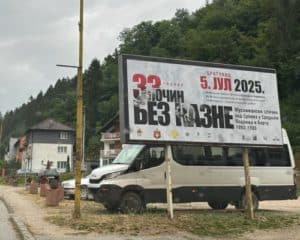 Huge billboards sponsored by the Orthodox church advertise a series of events marking the commemoration of 33 years since the people in the roadside pictures died. While Bosnian Muslims remember their tragedy, Bosnian Serbs are provided a daily schedule to keep them focussed on their own sense of historical suffering.
Huge billboards sponsored by the Orthodox church advertise a series of events marking the commemoration of 33 years since the people in the roadside pictures died. While Bosnian Muslims remember their tragedy, Bosnian Serbs are provided a daily schedule to keep them focussed on their own sense of historical suffering.
Another huge billboard erected in the centre of Srebrenica describes the genocide of Serbs during the Second World War, at the Ustasha-run Jasenovac concentration camp. Between 80,000 to 100,000 Serbs, Jews and Roma were murdered there. Placing posters in Srebrenica, in July, somehow suggests that the Srebrenica genocide is explained or justified by what happened to Serbs at the hands of Croatian fascists, five decades earlier.
As the speeches continued in the Memorial hall, I heard within them distant echoes of millennium-old struggles and atrocities, reaching up through time to shape present day identities and politics.
Many empires have come and gone from the region. The Romans; Byzantine Christendom, overthrown by the Ottoman empire, whose dominion lasted several centuries, deeply implanting its culture and religion in the region and establishing a group of indigenous European Muslims. Then, the Austro-Hungarian empire annexed Bosnia in 1908. Tensions with Serb nationalists led to the assassination of its heir, Franz Ferdinand and his wife Sophia in Sarajevo, sparking WWI and changing the world as we know it. Then came the Nazis, followed by forty-seven years of socialism. As these empires rose, fell or fought, Bosnians were often caught and crushed between these fault lines.
Appeals at the ceremony on the one hand that Bosnia’s stable future lies within European Union, contrasted with strident speeches from Turkey’s leaders in the east; competition of memory between Muslims and Christian Orthodox, normalisation of the idea of a Greater Serbia fuelled by influence from Moscow, plus populist calls in the region for Europe to awake to right-wing perceptions of a Christian past all indicate a growth of the nationalisms that caused the bloody break-up of Yugoslavia in the first place.
The 30th commemoration of the Srebrenica genocide was dignified and beautifully organised. World leaders were rightly contrite. But memory runs deep in the Balkans, passed down from generation to generation. Old fears are easily awoken and manipulated to fuel new conflicts. Beneath our feet the tectonic plates are rumbling, warning of another Balkan ethno-political earthquake.
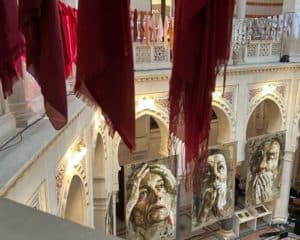 As I left Srebrenica, I caught sight of my hosts, the young women of the P-CRC, sitting on the veranda of a house belonging to the Mothers of Srebrenica, exhaustion showing on their faces. Maybe they were reflecting on whether the well-meaning words of visitors today would mean anything tomorrow.
As I left Srebrenica, I caught sight of my hosts, the young women of the P-CRC, sitting on the veranda of a house belonging to the Mothers of Srebrenica, exhaustion showing on their faces. Maybe they were reflecting on whether the well-meaning words of visitors today would mean anything tomorrow.
Will Srebrenica be forgotten for another decade or two, and will another deadly war resume before then?
The words of King Charles and others must not float away on the wind. The scarves of women shouldn’t hang as an ornament. They must flutter as a warning of what happens when truth is suffocated by lies, justice gives way to impunity, trust is eroded by fear and understanding gives way to hate.
There is time to prevent another tragedy in Bosnia. Needs of survivors should be met, killers brought to account, the memorial should be supported to challenge hate, education promoted to establish truth. Our weary friends there should not be forgotten. We must continue to work with them, and support them. And no price should be considered too much to scale the work of peacemakers in the region.

